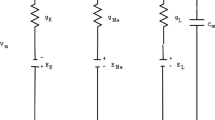Abstract
A three-dimensional network and its application to the analysis of images are described. This multilevel architecture studies partial correlations between structural components of an image. An algorithm is proposed that formalizes a new approach to the decomposition of images. An image is transformed so that each pixel contains information on the spatial structure of its neighborhood. The most correlated information is first formed, which ensures the resistance of the algorithm to small structural changes.
Similar content being viewed by others
References
D. Hinton, /’’Mapping part: Whole hierarchies into connectionist networks,” Artificial Intelligence,46, No. 1–2, 45–75 (1990).
D. L. Alkon. K. T. Blackwell, G. S. Barbour, et al.,“ Biological plausibility of synaptic associative memory models,” Neural Networks,7, No. 6/7, 1005–1017 (1994).
A. Lanitis, C. J. Taylor, and T. F. Cootes, “Automatic face identification system using flexible appearance models,” Image and vision computing,13, No. 5, 393–401 (1995).
R. Chellappa, C. L. Wilson, and S. Sirohey, “’Human and machine recognition of faces: a survey,” Proc. of the IEEE,83, 705–740 (1995).
S. Zeki, “A Vision of the brain,” in: Blackwell Sci. PubL Oxford (1993), pp. 43–50.
E. B. Babskii, A. A. Zybkov, G. I. Kositskii, et al., Physiology of Men [in Russian], Meditsina, Moscow (1972).
L. I. Timchenko, “Convergent and diverent processes in natural and artificial networks,” Visnyk VPI, No. 1, 5–10 (1997).
D. H. Huebel, Eye, Brain, and Vision [Russian translation], Mir, Moscow (1990).
D. O. Hebb, The Organization of Behavior, Wiley, New York (1949).
L. I. Timchenko, Y. F. Kutaev, and S. V. Chepornyuk, et al., “A brainlike approach to a multistage hierarchial image,” in: Proc. Image Analysis and Processing (Florence, Italy, Sept. 17–19, 1997), Springer-verlag (1997), pp. 246–253.
F. E. Blum, A. Lazerson, and L. Hofstadter, Brain, Mind, and Behavior, Freeman, New York (1985).
C. J. Shatz, “Impulse activity and the patterning of connection during CNS Development,” Neuron,5, No. 6, 745–758 (1990).
Ya. Abu-Mostafa and D. Psaltis, “Optical neuron-network computers,” Scientific American [Russian translation], No. 5, 42–50 (1987).
S. V. Svechnikov, V. P. Kozhemyako, and L. I. Timchenko, Quasiimpulse-Potential Optoelectronic Elements and Devices of the Logic-Temporal Type," Naukova Dumka, Kiev (1987).
M. A. Grudin, D. M. Harvey, L. I. Timchenko, and P. J. G. Lisboa, “Face recognition method using a multistage hierarchical network,” in: Proc. IEEE Intl. Conf. Acoust., Speech and Signal Proc. ICASSP97 (Munich, Germany, April 21–24, 1997), Vol. 4, Munich (1997), 2545–2548.
M. A. Grudin, L. I. Timchenko, D. M. Harvey, and V. P. Gel, “A system-theoretical approach to multistage hierarchical image processing,” in: Proc. EUROPTO Symp. (Besancon, France, June 11–14, 1996), Vol. 2785 (1996), pp. 225–234.
M. A. Grudin, D. M. Harvey, and L. I. Timchenko, “Multistage hierarchy for fast image analysis,” in: Proc. Eur. Symp. on Satellite Remote Sensing III (Taomina, Italy, 23–26 Sept., 1996), Vol. 2955, Taomina (1996), pp. 120–128.
L. Timchenko, S. Chepornyuk, M. Grudin, et al., “Use of three-dimensional multistage networks for facial image decomposition,” in: Proc. Machine Vision Appl., Architectures, and Systems Integration IV (SPIE Symp., Pittsburgh, USA, Oct. 14–17, 1997), Pitsburg (1997), pp. 55–60.
“V. Gel, L. Timchenko, I. Iwasyuk, et al. ”Neural network method for biosignal processing,“ in: Proc. 3th Int. Conf. Biosignal 96 Processing, Analysis of Biomedical Signals and Images, Brno (1996), pp. 128-130.
L. I. Timchenko, M.A. Grudin, V.P. Gel, et al., “A multistage hierarchical approach to image processing,” in: IEE Colloq. on Mulitdimensional Systems, P. 2.1–2.6 (London, UK, January, 1996), London (1996).
V. P. Kozhemyako, Y. F. Kutaev, L. I. Timchenko, et al., “Use of the Q-transformation method for facial image normalization,” in: Proc. International ICSC/IFAC Symp. on NEURAL COMPUTATION - NC’98 (Vienna, Austria, Sept. 23–25, 1998), Vienna (1998), pp. 287–291.
Y. Kutaev, L. Timchenko, A. Gertsiy, et al., “Compact representation of facial images for identification in a parallel-hierarchical network,” in: Machine Vision Systems for Inspection and Metrology, SPIE Symp. VII, (Boston, USA, Nov. 1–5, 1998), Boston (1998), pp. 157–167.
M. J. L. Orr, “An introduction to radial basis function networks,” Technical report. Center for Cognitive Sci.; Univ. of Edinburgh (Scotland), Edinburgh (1996).
P. Werbos, “Beyond regression: New tools for prediction and analysis in the behavioral sciences,” Ph.D. Thesis in Applied Mathematics, Harvard University, Harvard (1974).
D. E. Rumelhart, G. E. Hinton, and R. J. Williams, “Learning Representations by Backpropagation Errors,” Nature, 323, 533–536 (1986).
J. K. Aggarwal and Shishir Shah, “Object recognition and performance bounds,” in: Proc. Image Analysis and Processing (Florence, Italy, Sept. 17–19), Florence (1–997), pp. 343–360.
A. P. Stakhov, Introduction to the Algorithmic Theory of Measurements [in Russian), Sov. Radio, Moscow (1977).
D. J. Hall and G. B. Ball, “ISODATA: A novel method of data analysis and pattern classification,” Tech. Rep., Stanford Res. Inst.. Menlo Park (California) (1965).
T. Kohonen, “Self-organized formation of topologically correct feature maps,” Biol. Cybern., No. 43, 59–69 (1982).
R. Linsker, “Self-organization in a perceptual network,” Computer,21, No. 3, 105–117 (1988).
P. Maragos and R. W. Shafer, “Morphological systems for multidimensional signal processing,” Proc. IEEE.,78, No. 4, 690–710 (1990).
D. M. Harvey, S. P. Kshirsagar, C. A. Hobson, et al., “Digital signal processing system architectures for image processing,” in: Proc. of the 5th Intern. Conf. on Image Processing and Its Applications (Edinburgh, 1995), IEE Conf. Publ., No. 410 (1995), pp. 460–464.
Author information
Authors and Affiliations
Additional information
Translated from Kibernetika i Sistemnyi Analiz, No. 2, pp. 114–133, March–April, 2000.
Rights and permissions
About this article
Cite this article
Timchenko, L.I. A multistage parallel-hierarchic network as a model of a neuronlike computation scheme. Cybern Syst Anal 36, 251–267 (2000). https://doi.org/10.1007/BF02678673
Received:
Issue Date:
DOI: https://doi.org/10.1007/BF02678673




